This article focuses only on one specialized aspect of the subject.(May 2020) |
A hose bridge can be used by tram operators to avoid delays by not being able to cross over fire hoses.
This article focuses only on one specialized aspect of the subject.(May 2020) |
A hose bridge can be used by tram operators to avoid delays by not being able to cross over fire hoses.

When until the end of the 19th century a fire occurred in the down town district of Chicago, near one of the loops of the Chicago Surface Lines, all the lines of the company using that loop were in danger of being tied up for a long period. Crossover switches were placed on the trunk lines before they came to the loops but this provision was inadequate for the large number of cars. The street car tracks were more often blockaded by the loose lines than from the burning building or any other cause. [1]
The hose bridge used by the North Chicago Street Railroad Company for the trolley tracks resembled the bridges which were in service in many other cities. It consisted of a 2 inches (5.1 cm) oak plank on either side bound with 3⁄16 inch (4.8 mm) strap iron. Four semi-circular holes were cut to accommodate four lines of hose. Tie rods were spaced at intervals to hold the bridge to the proper gauge. The bridge was about 18 feet (5.5 m) over all and the inclines are such as to permit the cars to pass over it easily. [1]

It has been a much more difficult problem to design a suitable bridge for the cable tracks. One, which has been perfected by Superintendent F. L. Fuller in 1898, used two tripods. The legs of the tripods were 21 feet (6.4 m) in length and consisted of tubing, into the interior of which was driven a wooden pole. The bridge proper was divided into two parts each 12 feet (3.7 m). long. The floor was of 7⁄8 inch (22.2 mm) plank and the rest of the bridge was constructed of light angle iron. The two halves fitted together and were held in place by two long pins. [1]
The bridge ready to be sent to the fire was transported by a horse cart. As soon as it was taken to the scene of operation the two halves were laid across the tracks and pinned together. The lines of hose, any number less than nine, were placed in the bridge and a tripod set on each side of the tracks. A block and tackle was attached to an eye bolt in the apex of each tripod and the bridge with its load of hose was drawn up to the proper height. This whole operation could be performed by three men in less than eight minutes. The particular advantage of this bridge was that the lines of hose when filled with water could be lifted into place, which would have been a very difficult thing to do with almost any other form. [1]
Two of these bridges were kept in a barn at the rear of the general offices. In the office was located a city fire alarm, and as soon as the gong sounds the location of the fire was determined. If the fire was a serious one, the wrecking wagon was sent to the barn and the bridges, which were suspended overhead, were let down into the wagon and quickly dispatched to the proper point. Although designed especially for cable cars the trolley cars passed under it by drawing down the trolley pole. As one fire was liable to blockade nearly all the cars of a system this bridge was estimated to save its cost many times over during one emergency. [1]

The Chicago Tunnel Company was the builder and operator of a 2 ft narrow-gauge railway freight tunnel network under downtown Chicago, Illinois. This was regulated by the Interstate Commerce Commission as an interurban even though it operated entirely under central Chicago, did not carry passengers, and was entirely underground. It inspired the construction of the London Post Office Railway.

The San Francisco cable car system is the world's last manually operated cable car system and an icon of the city of San Francisco. The system forms part of the intermodal urban transport network operated by the San Francisco Municipal Railway, which also includes the separate E Embarcadero and F Market & Wharves heritage streetcar lines, and the Muni Metro modern light rail system. Of the 23 cable car lines established between 1873 and 1890, only three remain : two routes from downtown near Union Square to Fisherman's Wharf, and a third route along California Street.

Conduit current collection is an obsolete system that was used by some electric tramways to pass current to streetcars via a "conduit", a small tunnel under the roadway. Modern systems fall under the term ground-level power supply.

The Mount Lowe Railway was the third in a series of scenic mountain railroads in the United States created as a tourist attraction on Echo Mountain and Mount Lowe, north of Los Angeles, California. The railway, originally incorporated by Thaddeus S. C. Lowe as the Pasadena and Mt. Wilson Railroad Co., existed from 1893 until its official abandonment in 1938, and was the only scenic mountain, electric traction railroad ever built in the United States. Lowe's partner and engineer was David J. Macpherson, a civil engineer graduate of Cornell University. The Mount Lowe Railway was a fulfillment of 19th century Pasadenans' desire to have a scenic mountain railroad to the crest of the San Gabriel Mountains.

The Great Orme Tramway is a cable-hauled 3 ft 6 in gauge tramway in Llandudno in north Wales. Open seasonally from late March to late October, it takes over 200,000 passengers each year from Llandudno Victoria Station to just below the summit of the Great Orme headland. From 1932 onwards it was known as the Great Orme Railway, reverting to its original name in 1977.

The Chicago Aurora and Elgin Railroad (CA&E), known colloquially as the "Roarin' Elgin" or the "Great Third Rail", was an interurban railroad that operated passenger and freight service on its line between Chicago and Aurora, Batavia, Geneva, St. Charles, and Elgin, Illinois. The railroad also operated a small branch to Mt. Carmel Cemetery in Hillside and owned a branch line to Westchester.
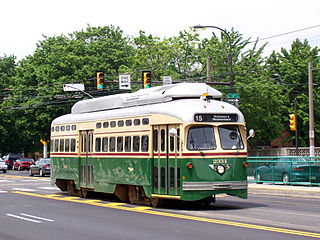
Route 15, the Girard Avenue Line, is a trolley line operated by the Southeastern Pennsylvania Transportation Authority (SEPTA) along Girard Avenue through North and West Philadelphia, Pennsylvania, United States. As of 2007, it is the only surface trolley line in the City Transit Division that is not part of the Subway–Surface Trolley Lines. SEPTA PCC II vehicles are used on the line.

Streetcars in Washington, D.C. transported people across the city and region from 1862 until 1962.

Pittsburgh Railways was one of the predecessors of Pittsburgh Regional Transit. It had 666 PCC cars, the third largest fleet in North America. It had 68 streetcar routes, of which only three are used by the Port Authority as light rail routes. With the Port Authority's Transit Development Plan, many route names will be changed to its original, such as the 41D Brookline becoming the 39 Brookline. Many of the streetcar routes have been remembered in the route names of many Port Authority buses.
The Capital Traction Company was the smaller of the two major street railway companies in Washington, D.C., in the early 20th century.

The MATA Trolley is a heritage streetcar transit system operating in Memphis, Tennessee. It began operating on April 29, 1993. Service was suspended in June 2014, following fires on two cars. After nearly four years and repeated postponements, the reopening of the Main Street Line took place on April 30, 2018. The system's two other lines remained suspended as of December 2022, but with reopening of both planned. In 2023, the system had a ridership of 365,400.
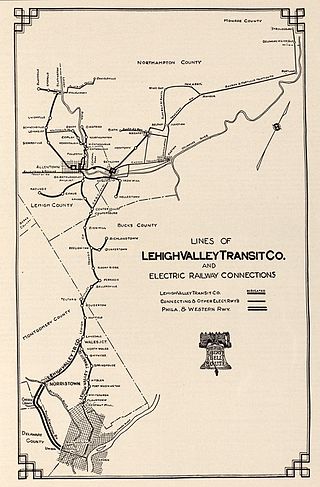
The Lehigh Valley Transit Company (LVT) was a regional transport company that was headquartered in Allentown, Pennsylvania. The company began operations in 1901, as an urban trolley and interurban rail transport company. It operated successfully into the 1930s, but struggled financially during the Great Depression, and was saved from abandonment by a dramatic ridership increase during and following World War II.
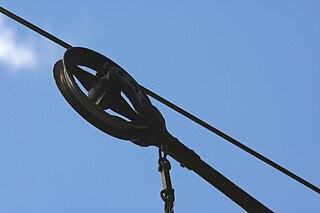
A current collector is a device used in trolleybuses, trams, electric locomotives and EMUs to carry electric power (current) from overhead lines, electric third rails, or ground-level power supplies to the electrical equipment of the vehicles. Those for overhead wires are roof-mounted devices, those for rails are mounted on the bogies.

The Roncesvalles Carhouse is a storage and maintenance facility for the streetcar network of the Toronto Transit Commission. Located at the northwest corner of the Queensway and Roncesvalles Avenue in Toronto, Ontario, west of its downtown core, it is the oldest of the TTC's three active carhouses. The carhouse serves vehicles on routes 501 Queen, 504 King, 505 Dundas, 506 Carlton, 511 Bathurst, and 512 St. Clair.
The Tramway Historical Society Inc. is located at the Ferrymead Heritage Park in the Christchurch, New Zealand suburb of Ferrymead and operates the standard gauge Ferrymead Tramway. Trams have operated at Ferrymead since 1968, with progressive extensions built between 1970 and 1984 allowing trams to operate within the boundaries of the Heritage Park. The Society also operates and own a collection of historic trolley buses and diesel buses.

The Williamsburg Bridge Trolley Terminal, also called the Essex Street Trolley Terminal or Delancey Street Trolley Terminal, was a trolley terminal located underground adjacent to the Essex Street subway station in the Lower East Side of Manhattan. Passenger trolley service operated through the terminal from 1908 until 1948 when trolley service over the Williamsburg Bridge ended. The station was constructed with balloon loops for turning around streetcars after they crossed over the Williamsburg Bridge to send them back to Brooklyn.
In 1900, Chicago already had the second largest cable car network in the United States and would eventually surpass New York City to have the largest streetcar network in the world in a few decades. In 1900, there were three private companies operating 41 miles (66.0 km) of double track routes radiating out from Chicago's downtown area. State of the art technology when the first line opened in 1882, by 1900 electric traction had proven superior and in 1906 all cable routes were changed to electrical power. Decades later, most were part of Chicago Transit Authority bus routes.
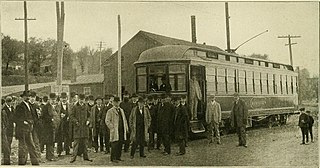
The line of the Elmira & Seneca Lake Railway Co. from Horseheads, New York to Seneca Lake was opened for operation on June 19, 1900.
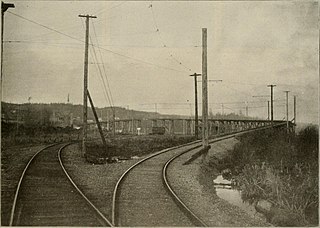
The Everett–Snohomish Interurban was a 9 miles (14 km) long interurban electric railroad between Everett and Snohomish, Washington. It was inaugurated by the Everett Railway & Electric Co. of Everett, on December 1, 1903.

The Georgetown Car Barn, historically known as the Capital Traction Company Union Station, is a building in the Georgetown neighborhood of Washington, D.C., in the United States. Designed by the architect Waddy Butler Wood, it was built between 1895 and 1897 by the Capital Traction Company as a union terminal for several Washington and Virginia streetcar lines. The adjacent Exorcist steps, later named after their appearance in William Friedkin's 1973 horror film The Exorcist, were built during the initial construction to connect M Street with Prospect Street.